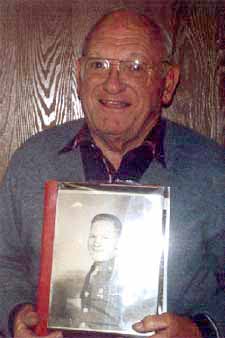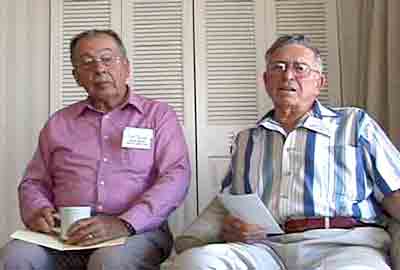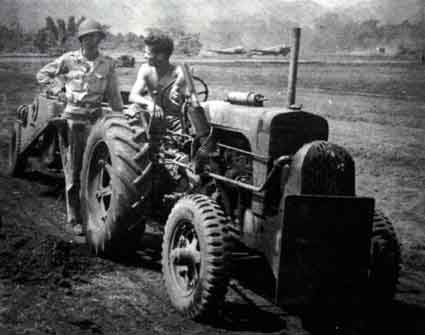|

Richard DeBaugh
41st FS P-47 Pilot
|
Richard DeBaugh
41st FS P-47 pilot recalls:
The strip, which was overlaid with Marston matting
(a metal runway which sounded as though you were landing in a junkyard)
had an eerily familiar look to it. Also, the revetment area was
very visible and pronounced; I could almost pinpoint the exact revetment
where I parked my plane. So your pictures provided me with a sort
of excitement in retrospect.
Read Island,
DeBaugh's essay about New Guinea
|

Walter Seale
871st Airborne Engineers |
Walter Seale
871st Airborne Engineers recalls:
While we were at Nadzab, doing rather routine earth
moving and grading, the Australian 9th Division landed north of
Lae and the US Army (I think the 41st Div) moved up from the south
until the Allied forces controlled the area. A road was pushed
through the swamp, by US engineers who had landed at Lae, to connect
wiith the Nadzab site. We were relieved and our next move was to
Gusap, northwest
of Nadzab. The airborne equpment was flown, as in the past. Rather
than disassemble and re-assemble the trucks and the D-4s it was
decided to convoy them overland. The area was without roads.
The convoy was for a considerable distance
I seem to recall that it was about fifty miles. Without roads,
the convoy had to break a trail through the kunai grass, find places
to ford the streams, excavate fording ramps, get across the stream
and then winch all their equipment across. It took ten days or
two weeks, or so. We lost one man, Cpl Heacock, a Medic, who drowned
in a swollen stream.
At Gusap we, again, quickly built
a 3,500 foot emergency runway and then began to expand it. About
this time the Fifth Air Force re-evaluated their situation and decided
to move their base up to Nadzab and to make Gusap an advance base.
The road to Nadzab solved the supply problem from the port at Lae.
Gusap remained without a road connection.
As time went on the 312th
Bomb Group (A-20s) and the 41st
Fighter Group (P-47s) moved up to Gusap, as did two other airborne
engineer battalions (I think they were 872 and 873) The runway was
graded and stabilized with sprayed emulsion mix, taxiways and hardstands
were built and at least part of the runway was covered with steel
matting. The requirement to transport all the materials by air
limited what it was practical to do. We built a tower and an operations
building. The building was a pre-fab unit made in Australia. The
sections came folded up. When erected, it had a metal roof, burlap
and screen wire sidewalls and a gravel floor.
Fuel for airplanes, and for everything
else, was shipped up in 55 gallon steel drums. The drums were
re-cycled, by welding, into culvert pipe needed for drainage. It
rained so much at Gusap! It was horrible. Your spare shoes would
get moldy. Everything got rusty. Your wash wouldn't dry. We were
there in the rainy season, I guess. The "other season" would have
to be the "wet season", and there is no "dry season". |

Bob Brewer (l) &
James Hilburn (r), 2000

James Hilburn, 41st FS
loading .50 caliber ammo
|
James Hilburn
41st Fighter Squadron, Armor
Shooting down a Lost Zero:
I was an armor, hanging and fusing bombs
and putting in .50 cal ammo. We had P-39's at Gusap and Nadzab and
we got P-47. The fields were primitive. Sometimes we would have
a few 100 foot of marston matting if it was available. About mid
afternoon a Zero approached field at pattern alt. and slow speed.
There was no alert sounded. He was down wind, made a left turn and
lined up on strip before an alarm was sounded. We
had a P-47 up with a new engine getting solo time on it. This pilot
was in the right place to get on his tail. One short burst and then
the Jap tried to leave but it was too late. I am sure that he was
lost and wanting down. There is no other reason he would have been
alone and coming in so low and slow. It was a sad event that did
not have to happen. This was all in plain eyesight of the airfield.
It has always been my opinion that he was lost and looking for a
place to land. Most certainly, this belief could not be debated
under circumstances, but why was he alone at slow speed?
An Enemy Phantom Fly-by...
I was in a little field hospital which was located
in a beautiful coconut palm grove. I am guessing the runway was
about 5 miles from it. We believed it was property of Palmolive
Peat Company. The palm grove was somewhat higher ground and made
visibility good. Anyway I was in the chow line for breakfast when
5 fighter planes came over heading for the airfield. They were not
Zeros as they did not have radial engines. As they flew by people
in the chow line wondered what they were. At that moment 50 cal
tracers filled the air around the airfield. The 5 planes went right
on through it. AA guns were all around the field and as I remember
each battery had 4 50s' on a platform that turned 360 deg. How they
all missed is a miracle. I do not know if and damage was done but
41st received none. Also while I was in the hospital John Wayne
came in visiting and I played a game of chess with him. I have his
autograph on my photo album.
|
| |
Dan
41st FS P-47 Pilot recalls:
If my memory serves me, from Jan 1944 at Nadzab
to Mar 1944 at Gusap we only had the 210 gal. centerline tank on
the P-47 D2s and D-10s. These were razorback P-47s. Later on the
39th got the first bubble canopies, P-47 D-23s. They had a different
fuel management system and a lot more range andcould handle the
wing mounted tanks. I think the 40th and 41st went to Noemfoors
with the razorback models. Someone in that time period could verify
it. In Oct. 1944 at Owi the 40th and 41st got the D-28s with the
internal 100 gal fuselage tank behind the pilot, plus the wing points
for the 165 gal tanks. By that time we were a long way from Gusap
and Nadzab. The centerline tank was a real hazard. It was hard to
get rid of, and no way to jettison in a hurry. Flat tires, loss
of power, usually resulted in the airplane settling on the tank
and creating a major accident. In the 35th Group history Ed Doss,
Group C.O. sent several letters to 5th Fiter C ommand to get a major
electrical wiring modification to enable the pilot to get separated
from the tank. The pilots we lost were detailed in the letter, and
most of these were due to the burns incurred from the centerline
gasoline sprayed around the sliding airplane. I hope some other
members can add to my memories. |




